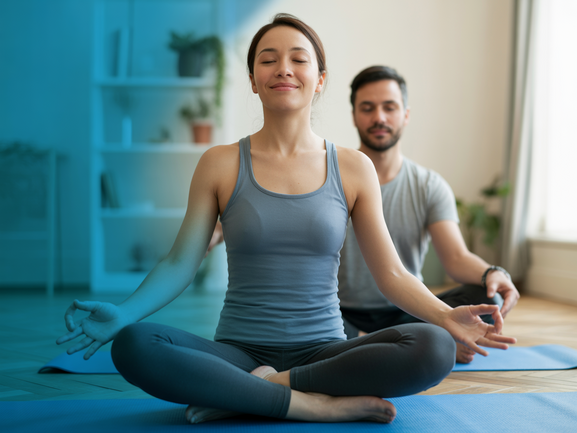How Yoga and Body Movement Can Transform Your Anxiety Into Calm
Did you know that over 40 million adults in the United States experience anxiety disorders each year? If you’re reading this, chances are you’re one of them, searching for natural ways to find peace amidst life’s chaos. The good news? Ancient practices like yoga and mindful movement offer powerful, scientifically-backed solutions that can transform your relationship with anxiety.
While anxiety may feel overwhelming, your body holds incredible wisdom for healing. Through gentle movement, controlled breathing, and mindful awareness, you can learn to calm your nervous system and cultivate lasting inner peace. Let’s explore how yoga becomes your ally in this journey toward serenity.
The Science Behind Yoga for Anxiety Relief
Research consistently shows that yoga practice activates the parasympathetic nervous system—your body’s natural “rest and digest” response. When you move through yoga poses while focusing on your breath, several remarkable things happen:
- Cortisol levels decrease: Studies published in the Journal of Clinical Medicine demonstrate that regular yoga practice significantly reduces stress hormones.
- GABA production increases: This neurotransmitter promotes feelings of calm and relaxation, naturally countering anxiety symptoms.
- Heart rate variability improves: Better HRV indicates a more resilient nervous system capable of handling stress effectively.
Furthermore, yoga’s emphasis on present-moment awareness interrupts the anxiety cycle of future-focused worry. When you’re fully engaged in a pose, your mind has less space for anxious thoughts to spiral.
5 Essential Yoga Poses for Immediate Anxiety Relief
These gentle poses can be practiced anywhere, anytime you need to reset your nervous system. Moreover, they require no special equipment—just your body and breath.
1. Child’s Pose (Balasana)
This grounding pose immediately signals safety to your nervous system. Kneel on the floor, touch your big toes together, and separate your knees hip-width apart. Fold forward, extending your arms in front of you or alongside your body. Hold for 1-3 minutes while breathing deeply.
2. Cat-Cow Stretch (Marjaryasana-Bitilasana)
This flowing movement releases tension in your spine while coordinating breath with movement. Start on hands and knees, then alternate between arching your back (cow) and rounding it (cat). Continue for 5-10 breaths, moving slowly and mindfully.
3. Legs-Up-The-Wall Pose (Viparita Karani)
This restorative pose activates the relaxation response almost immediately. Lie on your back near a wall, extending your legs up the wall. Rest your arms by your sides and breathe naturally for 5-15 minutes.
4. Forward Fold (Uttanasana)
Standing forward folds calm the nervous system while encouraging introspection. Stand with feet hip-width apart, hinge at your hips, and fold forward. Let your arms hang or hold opposite elbows. Sway gently if it feels good.
5. Corpse Pose (Savasana)
Never underestimate the power of conscious relaxation. Lie flat on your back, arms slightly away from your body, palms up. Close your eyes and systematically relax each part of your body, starting from your toes and moving upward.
Creating Your Daily Anti-Anxiety Movement Routine
Consistency trumps intensity when it comes to anxiety management. Even 10-15 minutes of daily practice can create profound shifts in your mental state. Here’s how to build a sustainable routine:
Morning Ritual (5-10 minutes)
Start your day with gentle stretches and breathing exercises. This sets a calm tone before life’s demands take over. Consider beginning with guided morning practices that ease you into the day.
Midday Reset (5 minutes)
When stress peaks during your day, take a brief movement break. A few minutes of deep breathing or gentle twists can reset your nervous system. These micro-practices are incredibly effective for busy schedules.
Evening Wind-Down (10-15 minutes)
End your day with restorative poses that signal to your body it’s time to rest. This practice improves sleep quality, which directly impacts anxiety levels the following day.
Building a Sustainable Practice with Online Yoga Platforms
While creating a home practice is empowering, having expert guidance accelerates your progress. Online platforms offer the perfect balance of convenience and professional instruction. Vitalizen.app provides specifically designed sequences for anxiety relief, allowing you to practice whenever and wherever you need support.
The beauty of online yoga lies in its accessibility. Whether you have 5 minutes or 50, there’s always a practice waiting for you. Additionally, you can repeat favorite sessions, building familiarity and confidence in your practice.
Many practitioners find that structured programs help them stay consistent. Look for platforms offering progressive courses that build skills gradually while addressing specific concerns like anxiety management.
Frequently Asked Questions About Yoga for Anxiety
How quickly does yoga help with anxiety?
Many people experience immediate calming effects during their first yoga session. However, lasting changes typically develop over 4-8 weeks of consistent practice. The key is regularity rather than intensity.
Do I need to be flexible to start yoga for anxiety?
Absolutely not! Yoga meets you where you are. Anxiety-focused practices emphasize breath and gentle movement rather than advanced poses. Flexibility develops naturally over time.
What’s the best time of day to practice yoga for anxiety?
The best time is whenever you can be consistent. Morning practice sets a calm tone for the day, while evening sessions help process daily stress. Listen to your body and schedule accordingly.

